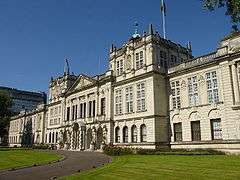Urdd Gobaith Cymru
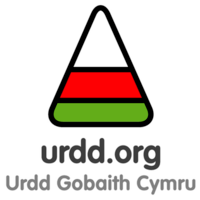
Urdd Gobaith Cymru Welsh pronunciation: [ˈɨrð ˈɡɔbaɪθ ˈkəmrɨ],Or, the Welsh League of Hope, but normally translated as the Welsh League of Youth, or merely referred to as the Urdd, is a youth movement based in Wales. The organisation's aim is to give children and young people the chance to learn and socialise in the Welsh language and it has "played a significant role over the past 90 years in promoting a Welsh and Welsh-speaking citizenship amongst Welsh youth".[1] It is the largest organisation for children and young people in Wales, with over 55,000 members.[2][3] The Urdd organises activities for its members ranging from small-scale meetings to the Urdd National Eisteddfod, which lasts for a week, and is attended by tens of thousands of visitors (over 100,000 in 2005) and is televised on S4C.[4]
History
.jpg)
through an appeal in the children's magazine Cymru'r Plant ("the Children's Wales"). The first Urdd local branch was established in Treuddyn in 1922. In 1925 the first "Peace and Goodwill Message" from the youth of Wales to the youth of the world was issued by the Urdd, a custom that continues every year on 18 May. The logo of the Urdd is a triangle of green (symbolising Wales), red (symbolising fellow-man), and white (symbolising Christ): faithfulness to these three elements is the basis of the Urdd's motto. A version of this logo with eyes, arms and legs becomes the character Mistar Urdd.
There are three age groups within the Urdd: primary (school) members under 11, secondary (school) members between 11 and 16, and senior members between 16 and 25. The Urdd is organised into local groups whose catchment areas are based on those of the Welsh-medium schools of Wales. These groups in turn are organised into larger county-based regions. Competitions organised by the Urdd include sports (including rugby union, swimming, darts, and pool amongst others); and arts, which are generally contested at eisteddfodau. Competitions begin at the local stage. Winners of local competitions go on to regional competitions; winners of these then progress to the national finals, which for non-sports competitions is the Urdd National Eisteddfod. Depending on the intensity the school brings to the matter, school eisteddfodau and Urdd competitions can be a major aspect of being in school in Wales.
The Urdd has several residential centres, two of which began as campsites -
- the first to be established (in 1932) was in Llangrannog, called Gwersyll yr Urdd Llangrannog
- at Glan-llyn by Llyn Tegid, called Gwersyll yr Urdd Glan-llyn
- in the Wales Millennium Centre in Cardiff, called Gwersyll yr Urdd Caerdydd, which includes the Urdd City Sleepover[5]
- at Pentre Ifan, called Canolfan yr Urdd Pentre Ifan
As well as trips to these centres, the Urdd organises trips abroad for its members.
Mistar Urdd
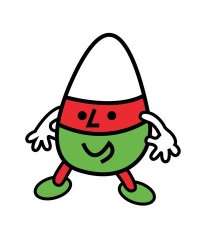
Mistar Urdd (Mr Urdd) is the personification of the triangular red, white and green logo of Urdd Gobaith Cymru.
Created to try get kids to be patriotic. Mistar Urdd became a hugely popular figure, touring schools and attending Eisteddfodau. Plush versions of the character were available in a range of sizes, and his image has been used on a number of T-shirts. ( note: Mr Urdd already existed in 1974 in comic book form - see http://www.walesonline.co.uk/news/wales-news/whod-thought-mr-urdd-dark-2341160 ).
Although well known within Wales for three decades, Mistar Urdd's fame has been spread further afield thanks to the rock band Super Furry Animals whose song Trôns Mr Urdd (Mr Urdd's Underpants) is a tongue-in-cheek tribute to the character. The song appears on the B-Side of the band's 1997 single Hermann Loves Pauline and on the American special-edition version of their album "Mwng".
Coincidentally, Mistar Urdd's own pop career reached its pinnacle during the mid-1970s with a song by the singer-songwriter Geraint Davies titled Hei, Mistar Urdd, including the classic chorus:
- Hei, Mistar Urdd yn dy goch gwyn a gwyrdd
- Mae hwyl i gael ym mhobman yn dy gwmni.
- Hei, Mistar Urdd, tyrd am dro ar hyd y ffyrdd,
- Cawn ganu'n cân i holl ieuenctid Cymru.
which translates into English as:
- Hey, Mr Urdd in your red, white and green,
- There's fun to be had in your company everywhere.
- Hey, Mr Urdd, come for a stroll along the roads,
- We'll sing our song to all of Wales's youth.
Gallery
| Urdd sites |
|---|
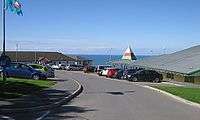 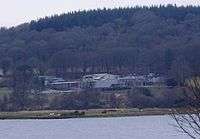 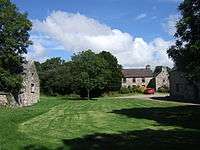 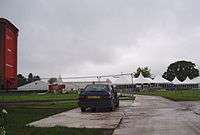 |
References
- ↑ Jones, Rhys; Merriman, Peter; Mills, Sarah (2016). "Youth organisations and the reproduction of nationalism in Britain: the role of Urdd Gobaith Cymru". Social & Cultural Geography. 17 (5): 714–734.
- ↑ "Urdd Gobaith Cymru Annual Report 2014-2015" (PDF). Urdd Gobaith Cymru. Urdd Gobaith Cymru. Retrieved 16 November 2016.
- ↑ "Our History". Urdd Gobaith Cymru. Urdd Gobaith Cymru. Retrieved 16 November 2016.
- ↑ "Urdd Eisteddfod 2014: Top ten facts about the festival", Daily Post, 7 May 2014. Accessed 30 November 2014
- ↑ Wales Millennium Centre website. Accessed 30 November 2014
External links
- Official website in Welsh
- Official website in English
- Mistar Urdd's 30th birthday (Website in Welsh)
